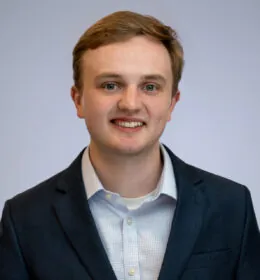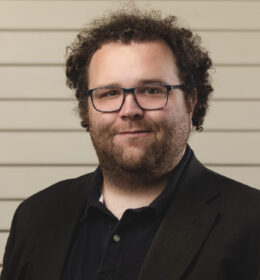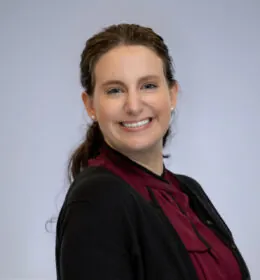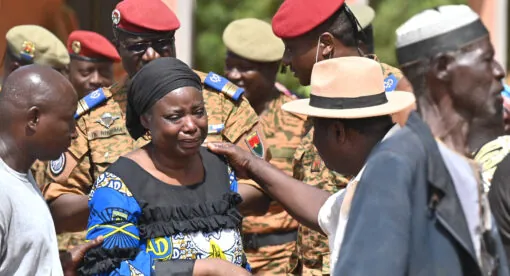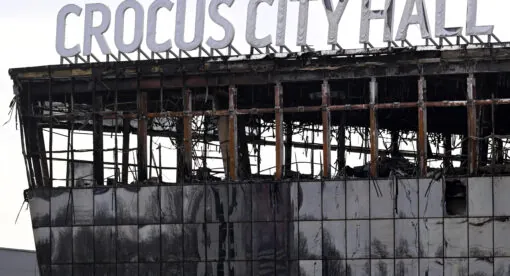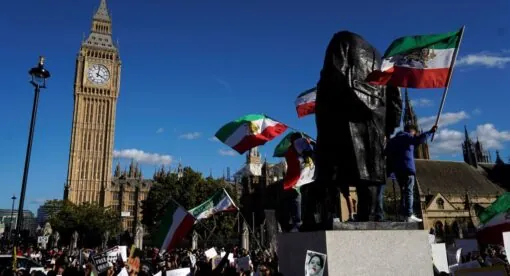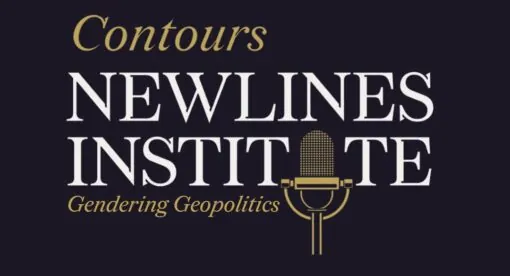In the latest Contours episode, host Carolyn Moorman approaches the long-term ramifications of late August’s clashes between local Arab tribes in Deir ez-Zour and the SDF on the long-term U.S. strategy in Syria with New Lines’ Calvin Wilder and Aram Shabanian.
Carolyn Moorman:
Hello and welcome to the Contours Podcast by the New Lines Institute for Strategy and Policy. Today, we’ll be discussing the violent clashes that occurred between the US-backed SDF, Syrian Democratic Forces, and local Arab tribes in eastern Syria in the end of August. These clashes killed about 90 people and occurred in Deir ez-Zor, which is the Syrian province located on the Syrian-Iraqi border. This province has loads of activity from a variety of actors, including the SDF, Arab tribal groups, Iranian-affiliated militias, and the Islamic State. The Euphrates River that runs throughout the province also separates land controlled by the US allies, the SDF, and that of the Assad regime and its Iranian-affiliated groups. All of these factors make the area very geostrategically vital to US interests in Syria and the greater Middle East. We’ll be diving into this issue set today with two great guests.
The first is Calvin Wilder. He’s a senior analyst for the special initiatives portfolio at New Lines, where he leads the Non-state Actor Accountability Project. Prior to joining the institute, Calvin was a research assistant at the Washington Institute for Near East Policy’s program on Arab politics, where his research focused on economic and humanitarian issues in territories held by non-state actors in Syria. He previously worked as a research assistant on the Chicago Project for Security and Threats’ Arabic propaganda analysis team, translating and analyzing Arabic language propaganda produced by ISIS, Al-Qaeda, and other extremist groups.
Also joining us is Aram Shabanian. Aram is the open-source information-gathering OSIG manager at New Lines. He monitors conflicts and outbreaks of violence around the world, including in the Middle East and Asia. His work utilizes a mixture of traditional research methods with modern-day, technology-assisted, open-source intelligence. Aram is also the founder of The Fulda Gap, which is a student-run site dedicated to informing people of international relations topics considered too complicated to discuss.
Thank you, Calvin and Aram, for being here today. To get us started, I’d like to turn to you, Aram, and ask about what started this whole incident in the first place. So we know that the tribal leaders participating in the fighting against the SDF, that these two groups have had problems for a while, and I’m wondering, what do you think flared up this violence specifically now? We know that it happened shortly after the SDF arrested the Deir ez-Zor military council leader Ahmed Al-Khubail, who is better known as Abu Khawla, but that both sides have denied that his arrest was the sole reason for this, or even the final straw in this scenario. What were you able to pick up from the information space about this specific round of violence?
Aram Shabanian:
From what I was able to gather, a lot of it comes down to long-stemming frustrations with corruption and injustice in the region, and this seemed to be kind of the straw that broke the camel’s back. The commander who was arrested was quite popular with his people. But beyond that, there were rumors. And I can’t personally confirm these because I’ve heard both sides of this rumor, but there were rumors that the Assad regime and its Iranian allies were looking to try to instigate some kind of unrest in the region between the SDF and its Arab allies. Now, whether or not these tribes were working in cahoots with those organizations or whether or not they were duped themselves with disinformation or something to that effect, I can’t say. But that’s just the rumor that’s been going around as to why this was a flashpoint. So it seems like there was probably a lot of instigation from outside forces that prompted this clash, which very rapidly spiraled out of control.
Carolyn Moorman:
And now that we’re in the middle of September and the situation seems to have calmed down a bit for now, what can you tell us about the near-term death toll? I’m wondering if you have any updates on this and any other property damage that occurred because of this?
Aram Shabanian:
Yeah, I mean, there were several cities, 11 locations in total that I could count that rose up, and all those cities were later retaken by the SDF. And so there was damage in those cities. No shelling or anything to that nature. It wasn’t like when the Assad regime would conquer a city and level it, but there’s, of course, battle damage to the cities. About 25 people were killed on the SDF side, and around 57 to 60 were killed on the Arab tribes’ side. And about nine or 10 civilians were killed, among them a child who was accidentally shot at a checkpoint confrontation. And that child’s death, I know, inflamed a lot of the local populace. They said, “No matter the reason, even if it was an accident, a child was killed because two sides couldn’t get along and couldn’t settle their disputes, and that’s unforgivable.”
Carolyn Moorman:
You mentioned this death of this child, and you also mentioned that you’ve heard that these protests have also developed from long-term problems between the two sides. And Calvin, I’d like to dive into this a little bit more with you. The tribes have said on their side that for a while the SDF has been discriminating against them with heavy-handed security tactics due to a variety of reasons, but mainly that the SDF, as we know, is mainly made up of Kurdish groups, and these tribes are primarily Arab. Mazloum Abdi came out a little while ago as the leader of the SDF and said that the protests were orchestrated by the regime and/or Iran, but that the legitimate concerns of the tribes would be addressed.
So I kind of have a three-part question for you. The first part is, are these complaints by these tribes legitimate? Two, is this something that the SDF commonly uses as an excuse per se, about the regime or Iran is behind whatever problems occur in the regions that are under their control? And three, do you think that change will actually come out of this statement from Abdi, or can we see it again as a way for the SDF to save face when it comes to their wrongdoing?
Calvin Wilder:
Hi, Carolyn. It’s a really great question, and thank you so much for having me. It’s great to be here today talking about these issues. I think when you’re talking about the grievances that the Arab tribes in Deir ez-Zor have with the SDF, it’s helpful to maybe sort of subdivide it into three kind of broad categories. There’s tension in a cultural sense. There’s tension in a political sense, and then there’s tension over economic issues as well. So I’ll just run through each of those briefly to kind of give an overview of where these issues are coming from and sort of what the long-term problems are.
On the cultural level, the SDF is both Kurdish-led, and it’s also predominantly… The backbone of the SDF is the YPG, which has its own unique sort of cultural and ideological commitments. The YPG itself not being transnational, but having its roots with other transnational Kurdish groups, so there’s sort of specific commitments there. Just to give one example or some color here: When the SDF moved into Raqqa, which was in about 2017, they retook the city from ISIS, and Raqqa obviously is a majority Arab city, they hung up large posters of Abdullah Ocalan in the town square, and Ocalan obviously being the Kurdish leader of the PKK. So, that caused a lot of gripes and a lot of local angst because it’s like, why is there this poster of this Kurdish person who’s not Syrian, who doesn’t have anything to do with this fight from our perspective, being hung as though this is sort of his victory? So those sorts of issues have kind of persisted over time. Those specific posters were taken down relatively quickly, but that’s something that people often cite as indicative of a broader issue.
You can also look at the Autonomous Administration, which is the civilian body of the SDF or the civilian affiliate of it, has worked to sort of expand Kurdish language instruction in public schools in northern Syria, which has caused a lot of grievances with non-Kurdish speakers. There’s been pressure to appoint female leadership to political and military bodies, which is something that the SDF and the YPG and the Autonomous Administration feel really strongly about, and that’s something that’s chafed in more traditional areas outside of the SDF’s traditional area of control. So there’s been kind of all of these different cultural tensions there. I think it’s important to caveat this by saying most of these tensions have been concentrated farther north than Deir ez-Zor, so it’s not necessarily a great explanation for specifically what we’re seeing now, but that tension does exist.
Then on the political level, you’re sort of seeing basically people in Deir ez-Zor have been saying for a long time that they don’t feel like they’ve had adequate input into the broader SDF structure. They feel like they’ve been sidelined, and they’ve said that they want more direct access to the Operation Inherent Resolve leadership. So they want more direct lines of communication with the US military in northern Syria, as opposed to having that all mediated through the top levels of the SDF, which is predominantly Kurdish.
And then that’s also manifested in sort of a lack of transparency over arrests. So the SDF will oftentimes arrest Arab citizens in Deir ez-Zor and then label them as ISIS members. But because the Autonomous Administration doesn’t have a terribly robust court system at this point, to say the least, there’s a lot of tension over whether or not these people are actually ISIS in every case, whether or not there’s transparency in why they’re being arrested in the first place. Is there political motivation? So that’s been a long-running grievance going back to about 2017. It’s also heightened things.
And then on the economic front, there’s kind of, this is the hardest one to talk about. I’d say it’s probably the murkiest. But it’s just worth noting that in Deir ez-Zor specifically, there is where oil is concentrated in Syria. So there’s a lot of oil being pumped out of Deir ez-Zor, and then there’s not a lot of transparency in where that’s going. It’s getting sold in some cases to Iraqi Kurdistan. In most cases, it’s being sold to the Assad regime, and most of that buying and selling is handled by the SDF senior Kurdish leadership on some level. So there’s sort of gripes with these Arab tribes who are saying, “Hey, where’s this money going? Why are we not seeing enough of it?” It’s not totally clear what to make of that because that whole economy is extremely murky. It’s mostly dictated by the black market, but it’s just worth signaling that that’s something that comes up in these conversations as well.
So, it’s sort of those three broad buckets that I think have led to the tension here. And in terms of whether or not we’re going to see any changes, I just think, honestly, it’s probably too soon to tell. I think it’s big news that Abdi has really acknowledged that these tensions are legitimate, that there’s actual things that should be done differently, but you have to wait and see how much actual follow-through there is. Even where there’s political will, the Autonomous Administration’s state capacity is extremely limited. So it’s not as though Abdi can just sort of wave a magic wand and then solve all of these issues. It’s going to require a lot of sustained effort by all parties.
Carolyn Moorman:
We saw that the US sent senior diplomatic and military officials to the area to calm down the situation. I mentioned in the beginning of the podcast how important this province, this area of Syria is to US interests in the region and in the country. Calvin, what more can you tell us about the US’s response to this situation? And do you think it was appropriate and as big of a response as it should have been given this violence, or do you think the US should have done more?
Calvin Wilder:
Yeah, it’s hard to know what more the US could have done. I mean, I think being restrained is really appropriate here. The worst thing that the United States, I think, could do when they see something like this flaring up and there’s obviously a potential for things to spiral out of control, is there’s going to be a strong impulse to just decisively back one side or the other and just get this issue put down as quickly as possible. So if you’re saying, “Oh, could the US do more?” I mean, technically yes. They could just say, “We’re behind the SDF. We have full confidence in them,” and then just move forward that way. I think that that would paper over a lot of the actual grievances here and probably lead to much more serious problems in the long term. So I actually think some restraint and an effort to just be on the side of mediation and dialogue and pushing both sides to the negotiating table is really appropriate. And unfortunately, there’s not much more that the United States can do beyond just sending people to act as those mediators, which is what they did.
I think the challenge here is that the US footprint in northeast Syria is extremely limited. I mean, in all of Syria, we’ve probably officially got around 900 people, and the overwhelming majority of those people are not tasked with anything resembling a diplomatic role. They’re special forces, and they have a military or a military intelligence function. So the US just doesn’t have that much manpower to bring to bear on this issue, and they don’t have a lot of visibility onto the intricacies of it. I mean, like Aram noted, it’s just really hard to get to the bottom of why exactly did this arrest happen? What exactly are the deeper issues here? Who’s right? Who’s wrong? You know, if the US only has a dozen or so people that are even working on the ground on this, it’s going to be really hard to solve that.
And then on top of that, I would just say that part of the challenge here is that the US just works in an environment that is overwhelmingly mediated by the senior leadership of the SDF, right? I mean, US forces are co-located with the SDF, and the SDF has a lot of say in where they go and what they do on some level. So it’s just going to be really hard to get to the bottom of things in a neutral way that really takes seriously the grievances or has an honest understanding of the grievances of the Arab tribes in Deir ez-Zor when that’s the environment that you’re working in. So, I don’t know. It’s a really thorny issue, but I think that just in general, the US response of trying to bring to bear some diplomatic manpower and bring both sides to the negotiating table is probably the appropriate impulse.
Carolyn Moorman:
I think it’s really important, Calvin, that you brought up this important role that the US played of mediation, given that, of course, there are very big concerns on the table here in regards to, like we keep emphasizing, the importance of this region, this area to US interests, but also the chance for, if this was just swept under the rug, for these protests to turn into something more and to spread in their region and become something harder for the SDF and even US diplomatic support to put down.
Aram, you mentioned something earlier, which is the rumors that the Assad regime and its Iranian-affiliated allies could have had a role in kind of starting this in the first place or at least making this environment ripe for these protests to begin. Did you see any indicators on the back end that during all this fighting, during all this instability, other malign actors in the region, particularly the Islamic State, Iranian-affiliated groups were kind of reacting to this instability or looking at it differently or seeing it as a potential vacuum to kind of increase their power in Deir ez-Zor?
And if that was the case and even if it’s not, what signs would you be looking for to determine if this was happening or not? Because as Calvin has laid out, these concerns are multifaceted that these Arab tribes are bringing up, and I mean, I don’t want to speak for anyone here, but there’s a potential probably that something like this could happen again in the future if concerns are not addressed. So I’m wondering if this does happen in the future, what signs we should be looking for to see if this has a rippling effect to all of the other actors in Deir ez-Zor?
Aram Shabanian:
Yeah. One of the things that I noted… This is just a personal way that I notice things of this nature. I keep flight trackers open from time to time, and I try to see which aircraft are in the skies over eastern Syria and western Iraq. And on a given day, there will be a certain number of aerial refueling tankers in the air that are operated by the United States Air Force fueling, US combat jets that are on constant combat patrol over Iraq and Syria, waiting to be called in by either the SDF or the Iraqi forces to assist against Islamic State, namely. However, additional forces can be rushed to the region in the event of a showdown with a major Islamic State force or with other actors, namely Iranian militias.
In the last few weeks, I’ve seen two or three times the number of air tankers in the air that are normally up. So that means there’s a lot more combat jets in the air lately, and that’s been corroborated by reports on the ground of a lot of coalition jets kind of circling the skies over these clashes, not necessarily intervening directly, but keeping an eye on them. And so if I saw more coalition forces rushing to the region, I could judge that as a response to either Iranian militia movements or Islamic State. And then depending on what I saw in the rest of Syria and in Iraq, that would allow me to deduce namely who was behind it.
With regards to Iraq, there were developments in Kirkuk wherein the KRG’s Peshmerga pushed out the Iranian-backed PMUs around the same time these clashes were happening in Deir ez-Zor. And so the potential for a flashpoint with Iran was actually quite great, and I think a lot of people didn’t realize how tense things had gotten and how tense things still are with regard to the potential for an explosion in both Deir ez-Zor and Kirkuk.
Carolyn Moorman:
And with that, you’ve done a really good job for not only our organization, but also in all of your different capacities, such as like with The Fulda Gap that I’ve mentioned, and you’re very active, Aram, on Twitter, updating all of your followers and all of us about these developments that are to watch in Iraq and Syria.
For our final question, I’d like to return to you, Calvin, and see what kind of implications you see these clashes having for long-term US policy in Syria. You’ve outlined in a lot of the work that you’ve done for New Lines, whether that be podcasts or written products, that the SDF under US leadership plays a very important role in Syria, mainly ensuring that all of these former and current Islamic State members that are locked away in SDF-controlled prisons stay there.
And I’m wondering if this kind of situation, rather if we see it happen again or anything like this, do you think this has put cracks in how the US views the SDF’s ability to provide long-term security east of the Euphrates while remaining also in the good graces of the local population? Do you think the US is kind of looking at the SDF differently, and how do you think US leadership is thinking about this? I’m not assuming that the US is suddenly prepared to abandon the SDF, as I’m sure you also agree that that is not the case. But I’m wondering if this has brought up some larger constraints and problems that the US has to think about as it’s looking at long-term policy in Syria?
Calvin Wilder:
Yeah, absolutely. I mean, I’m glad that we’re recording this podcast now as opposed to a week ago, because I think there’s been a little bit of time for the dust to settle from this round of fighting in particular. If you’d talked to me a week ago, I think I would’ve been a lot more pessimistic. It really did look like things might be spiraling out of control, and it wasn’t totally clear how widespread the uprising was.
I think now that we can look back on it, the good news is, one, the fighting has died down relatively quickly. Two, I think both sides showed a fair amount of restraint. I mean, the death toll was considerable, as Aram mentioned, but as you also touched on, the amount of shelling that was involved was relatively limited. Neither side really brought the full weight of their armed forces to bear on this, I think it’s fair to say. So that was, I think, also good news that whatever was happening, whatever the primary cause was behind the fighting, both sides, I think, went about it in a way that suggested that neither of them wanted to see this spiral out of control too much.
And something that I think is really important to highlight here is whatever the grievances are between the tribes in Deir ez-Zor and the powers farther north in Qamishli and Kabani, both sides really, really do not like ISIS, and both sides really, really, really do not like the Assad regime. And they’re both aware that when there’s instability in Deir ez-Zor, there’s a strong possibility of either of those actors coming back in, exploiting that instability. So as long as both sides agree that that’s the worst-case scenario, they have a strong incentive to negotiate and to come to some sort of power-sharing agreement. So, I think that there’s some cause for optimism here. But at the same time, I definitely did highlight that the US military presence in northeast Syria is precarious, and it kind of counts on everybody getting along, including in the context where these people have really deep-seated grievances and tensions with each other. So that’s a really difficult challenge to manage.
I think I’ve said previously that the US mission in northeast Syria would really struggle to stay viable, I mean, I’m not sure it could stay viable at all, if you actually had both of these sides completely bifurcate and separate from each other. I mean, there needs to be some cohesion between Deir ez-Zor and the areas farther north in Hasakah in order for this to work economically and from a security perspective and for the US to have the freedom of movement it needs for counter-terrorism operations. So it definitely highlighted the fragility and the need to keep these things together. And it also highlighted, as I mentioned, that the US doesn’t have a magic wand that it can wave to make these things happen, that there’s an element of the two sides that are actually fighting needing to come together in good faith.
So I think it’s too soon to tell, but I think that the one thing that I can say for sure is that if we take for granted that the US position is at least a little bit precarious, it does highlight the importance of solving these long-term ISIS issues as quickly as possible, in particular, the detention of ISIS fighters. And that’s something that the US has been working on really hard in the past year, is repatriating ISIS fighters, getting them out of Syria. So when you have this type of instability, which raises the risk of jailbreaks, it diverts SDF attention, trying to basically reduce the risk or mitigate the risk by solving that issue, or at least reducing the total number of hardened ISIS fighters that are detained in these kind of makeshift facilities in northeast Syria, it definitely highlights the importance of doubling down on that and working as hard as you can on that, which I think it’s fair to say the US is doing at this point.
So yeah, it’s a really challenging situation, and it’s probably not satisfying to end on the note of just saying it’s too soon to tell. But a lot does hinge on, as we talked about, whether or not Mazloum Abdi and the tribes in Deir ez-Zor actually do negotiate and come to an agreement that works for both of them. So I guess we’ll just have to be kind of following this really closely and seeing what does and doesn’t get implemented over the coming weeks and months.
Carolyn Moorman:
This has been a wonderful conversation. I’m thankful for both of you for talking us through all of these protests, all of this violence, and kind of reorienting how we view US foreign policy, specifically in regards to Syria, and the role of the US in mediating disputes and how it positions itself not only as a security actor, but also when it needs to be a diplomatic actor in situations such as this. To our listeners, thank you so much for listening to this episode of Contours. Make sure to subscribe to the podcast on iTunes, SoundCloud, and Spotify. You can check out further analysis into geopolitics and US foreign policy at www.newlinesinstitute.org. All the best.

